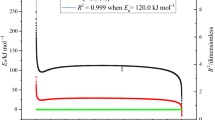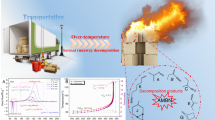Abstract
2,2′-Azobis (2-methylpropionate) (AIBME) is a new type of environmental-friendly oil-soluble azo initiator, extensively applied in the radical polymerization industry relying on its extraordinary thermal and physicochemical properties. Nevertheless, the special structure makes AIBME decompose easily under low ambient temperature with a tremendous amount of heat release. To qualify its thermal hazard and obtain the specific safety parameters such as time to maximum rate under adiabatic condition (TMRad) and self-accelerating decomposition temperature (SADT), differential scanning calorimeter (DSC), simultaneous thermogravimetric analyzer (STA), and accelerating rate calorimeter (ARC) were applied to analyze the thermal behaviors of AIBME while conducting the thermokinetic analysis and numerical curve fitting. The results indicate that AIBME decomposes at low temperature, and the SADT of AIBME in 25 kg UN package is 35.2 °C. Moreover, the temperature at TMRad = 8 h is determined at 51.6 °C using Townsend method. Compared with commercially used azo compounds, such as 2,2′-azobisisobutyronitrile (AIBN) and 2,2-azobis(2-methylbutyronitrile) (AMBN)), the predominant heat of decomposition, more gaseous degradation products, quicker heat release rate, and lower decomposition temperature make AIBME more hazardous during production, storage, and transportation. The results of this study can provide the references for the process safety assessment and the design of appropriate safety system in scale-up applications with the wish to avoid the occurrence of AIBME involved accidents.








Similar content being viewed by others
Abbreviations
- A :
-
Pre-exponential factor (s−1)
- C p :
-
Total heat capacity (kJ kg−1 K−1)
- C pB :
-
Bomb heat capacity (kJ kg−1 K−1)
- C ps :
-
Sample heat capacity (kJ kg−1 K−1)
- C 0 :
-
Initial concentration of the reaction (mol L−1)
- (dT dt−1)max :
-
Maximum temperature rise rate (°C min−1)
- (dP dt−1)max :
-
Maximum pressure rise rate (bar min−1)
- E a :
-
Apparent activation energy (kJ mol−1)
- k :
-
Rate constant (min−1)
- m B :
-
Bomb mass (g)
- m s :
-
Sample mass (g)
- M T :
-
Self-heating rate measured at temperature T (°C min−1)
- M m :
-
Maximum self-heating rate (°C min−1)
- n :
-
Reaction order (dimensionless)
- P :
-
Pressure (bar)
- P f :
-
Final pressure (bar)
- R :
-
Gas constant (8.314 J mol−1 K−1)
- S :
-
Contact area of the system and environment (m2)
- SADT :
-
Self-accelerating decomposition temperature (°C)
- t :
-
Time (min)
- t m :
-
Time at maximum temperature (min)
- T :
-
Temperature (°C)
- T on :
-
Onset temperature in DSC (°C)
- T 0 :
-
Initial temperature in ARC (°C)
- T p :
-
Peak temperature (K)
- T f :
-
Final temperature (°C)
- T m :
-
Maximum temperature (K)
- TMR ad :
-
Time to maximum rate under adiabatic conditions (min)
- T D8 :
-
Temperature at TMRad = 8 h (°C)
- T D24 :
-
Temperature at TMRad = 24 h (°C)
- T NR :
-
Temperature of no return (K)
- U :
-
Heat transfer coefficient (J m−2 K−1 s−1)
- W p :
-
Peak power at time (W g−1)
- α :
-
Conversion degree (dimensionless)
- β :
-
Heating rate (°C min−1)
- τ :
-
Time constant (min)
- Φ :
-
Thermal inertia (dimensionless)
- ΔHd :
-
Heat of decomposition (J g−1)
- ΔHad :
-
Heat of adiabatic reaction
- ΔT :
-
Temperature rise (°C)
- ΔTab :
-
Absolute temperature rise (°C)
References
Li XR, Wang XL, Koseki H. Study on thermal decomposition characteristics of AIBN. J Hazard Mater. 2008;159(1):13–8.
Liu SH, Yu YP, Lin YC, Weng SY, Hsieh TF, Hou HY. Complex thermal evaluation for 2,2′-azobis (isobutyronitrile) by non-isothermal and isothermal kinetic analysis methods. J Therm Anal Calorim. 2014;116(3):1361–7.
Shipp DA, Solomon DH, Smith TA, Moad G. Chain length dependence of radical-radical termination in free radical polymerization: a pulsed laser photolysis investigation. Macromolecules. 2003;36(6):2032–40.
Hirano T, Tanaka K, Wang HW, Seno M, Sato T. Effect of nitrobenzene on initiator-fragment incorporation radical polymerization of divinylbenzene with dimethyl 2,2′-azobisisobutyrate. Polymer. 2005;46(21):8964–72.
Dubikhin VV, Knerel’man EI, Manelis GB, Nazin GM, Prokudin VG, Stashina GA, Chukanov NV, Shastin AV. Thermal decomposition of azobis (isobutyronitrile) in the solid state. Cage effect. Recombination and disproportionation of cyanoisopropyl radicals. Dokl Phys Chem. 2012;446(2):171–5.
Gowda S, Abiraj K, Gowda DC. Reductive cleavage of azo compounds catalyzed by commercial zinc dust using ammonium formate or formic acid. Tetrahedron Lett. 2002;43(7):1329–31.
Yan C, Wang ZR, Liu K, Zuo QQ, Zhen YY, Zhang SF. Numerical simulation of size effects of gas explosions in spherical vessels. Simulation. 2017;93(8):695–705.
Globally Harmonized System of Classification and Labelling of Chemicals (GHS). United Nations Publications, 2009.
Guo S, Wan W, Chen C, Chen WH. Thermal decomposition kinetic evaluation and its thermal hazards prediction of AIBN. J Therm Anal Calorim. 2013;113(3):1169–76.
Zhang CX, Lu GB, Chen LP, Chen WH, Peng MJ, Lv JY. Two decoupling methods for non-isothermal DSC results of AIBN decomposition. J Hazard Mater. 2015;285:61–8.
Liu SH, Chen YC, Hou HY. Thermal runaway hazard studies for ABVN mixed with acids or alkalines by DSC, TAM III, and VSP2. J Therm Anal Calorim. 2015;122(3):1107–16.
Partington S, Waldram SP. Runaway reaction during production of an azo dye intermediate. Process Saf Environ. 2002;80(1):33–9.
Rao GN, Feng W, Zhang J, Wang SY, Chen LP, Guo ZC, Chen WH. Simulation approach to decomposition kinetics and thermal hazards of hexamethylenetetramine. J Therm Anal Calorim. 2019;135:2447–56.
Liu SH, Hou HY, Shu CM. Thermal hazard evaluation of the autocatalytic reaction of benzoyl peroxide using DSC and TAM III. Thermochim Acta. 2015;605(3):68–76.
Malow M, Wehrstedt KD, Manolov M. Thermal decomposition of AIBN. Part A: decomposition in real scale packages and SADT determination. Thermochim Acta. 2015;621:1–5.
Lin CP, Tseng JM, Chang YM, Cheng YC, Lin HY, Chien CY. Green thermal analysis for predicting thermal hazard of storage and transportation safety for tert-butyl peroxybenzoate. J Loss Prev Process Ind. 2012;25(1):1–7.
Sopacı ŞB, Nazır H, Emir E, Atakol O, Öz S. Thermal kinetic analysis, theoretical thermodynamic calculations and antimicrobial activity of three new energetic materials. J Therm Anal Calorim. 2018;131(3):3105–20.
Trache D, Abdelaziz A, Siouani B. A simple and linear isoconversional method to determine the pre-exponential factors and the mathematical reaction mechanism functions. J Therm Anal Calorim. 2017;128(1):335–48.
Toledo M. STARe software with solaris operating system, Operating Instructions, Switzerland. 2004.
ASTM. Standard Test Method for Kinetic Parameters for Thermally Unstable Materials Using Differential Scanning Calorimetry and the Flynn/Wall/Ozawa Method1: ASTM E 698–16.
Liu ZT, Zhang F, Du P, Xu B. Effect of NQ content on the thermal decomposition of nitroguanidine propellant using isoconversional methods. J Therm Anal Calorim. 2019;137:473–80.
Stoessel F. Thermal safety of chemical processes: risk assessment and process design. Wiley; 2008. p. 59–80. https://doi.org/10.1002/9783527621606.
Guidelines for chemical reactivity evaluation and application to process design, in American Institute of Chemical Engineers New York. 1995.
Lang QQ, Zhang B, Liu ZG, Chen ZL, Xia Y, Li D, Ma J, Gai C. Co-hydrothermal carbonization of corn stalk and swine manure: combustion behavior of hydrochar by thermogravimetric analysis. Bioresource Technol. 2019;271:75–83.
Wang Z, Wei RC, Ning XY, Xie T, Wang J. Thermal degradation properties of LDPE insulation for new and aged fine wires. J Therm Anal Calorim. 2019;137:461–71.
Šesták J. The quandary aspects of non-isothermal kinetics beyond the ICTAC kinetic committee recommendations. Thermochim Acta. 2015;611:26–35.
Gerami G, Bagheri R, Darvishi R. Investigation of isothermal and dynamic cure kinetics of epoxy resin/nadic methyl anhydride/dicyandiamide by differential scanning calorimetry (DSC). J Therm Anal Calorim. 2019;137:575–82.
Blaine RL, Kissinger HE. Homer Kissinger and the Kissinger equation. Thermochim Acta. 2012;540:1–6.
Pakkirisamy SV, Mahadevan S, Paramashivan SS, Mandal AB. Adiabatic thermokinetics and process safety of pyrotechnic mixtures. J Therm Anal Calorim. 2012;109(3):1387–95.
Sekar T, Ramaswamy SN, Nampoothiri N. Planning of industrial estate for fireworks industries in Sivakasi. Int J Eng Sci Technol. 2010;2(6):2207–17.
Sivapirakasam SP, Surianarayanan M, Vijayaraghaven R. Thermal characterisation and kinetic modelling of pyrotechnic flash composition under adiabatic conditions. J Pyrotech. 2006;23:61–6.
Zhu JP, Jin SH, Yu YH, Zhang CY, Li LJ, Chen SS, Shu QH. Evaluation of thermal hazards and thermo-kinetic parameters of N,N′-dinitro-4,4′-azo-Bis (1,2,4-triazolone)(DNZTO). Thermochim Acta. 2016;623:58–64.
Sasidharan N, Hariharanath B, Rajendran AG. Thermal decomposition studies on energetic triazole derivatives. Thermochim Acta. 2011;520(2):139–44.
Zhang CY, Jin SH, Chen SS, Li LJ, Zhou C, Zhang Y, Shu QH. Thermal behavior and thermo-kinetic studies of 5,5′-bistetrazole-1,1′-diolate (1,1-BTO). J Therm Anal Calorim. 2017;129(2):1265–70.
Townsend DI, Tou JC. Thermal hazard evaluation by an accelerating rate calorimeter. Thermochim Acta. 1980;37(1):1–30.
Ferguson HD, Townsend DI, Hofelich TC, Russell PM. Reactive chemicals hazard evaluation: impact of thermal characteristics of transportation/storage vessels. J Hazard Mater. 1994;37(2):285–302.
Yang XW, Zhang XY, Guo ZC, Bai WS, Hao L, Wei HY. Effects of incompatible substances on the thermal stability of dimethyl sulfoxide. Thermochim Acta. 2013;559:76–81.
Grewer T, Frurip DJ, Harrison BK. Prediction of thermal hazards of chemical reactions1. J Loss Prev Process Ind. 1999;12(5):391–8.
Yu YH, Hasegawa K. Derivation of the self-accelerating decomposition temperature for self-reactive substances using isothermal calorimetry. J Hazard Mater. 1996;45(2–3):193–205.
Chiang CL, Liu SH, Cao CR, Hou HY, Shu CM. Multiapproach thermodynamic and kinetic characterization of the thermal hazards of 2,2′-azobis (2-methylpropionate) alone and when mixed with several solvents. J Loss Prev Process Ind. 2018;51:150–8.
Liu SH, Shu CM. Advanced technology of thermal decomposition for AMBN and ABVN by DSC and VSP2. J Therm Anal Calorim. 2015;121(1):533–40.
Liu SH, Lin WC, Hou HY, Shu CM. Comprehensive runaway kinetic analysis and validation of three azo compounds using calorimetric approach and simulation. J Loss Prev Process Ind. 2017;49:970–82.
Cao CR, Liu SH, Shu CM. Reaction simulation of multistage evaluations for AMBN based on DSC experiments. Thermochim Acta. 2018;661:18–26.
Moukhina E. Thermal decomposition of AIBN. Part C: SADT calculation of AIBN based on DSC experiments. Thermochim Acta. 2015;621:25–35.
Roduit B, Hartmann M, Folly P, Sarbach A, Brodard P, Baltensperger R. Determination of thermal hazard from DSC measurements. Investigation of self-accelerating decomposition temperature (SADT) of AIBN. J Therm Anal Calorim. 2014;117(3):1017–26.
Liu SH, Lu YM, Su C. Thermal hazard investigation and hazardous scenarios identification using thermal analysis coupled with numerical simulation for 2-(1-cyano-1-methylethyl)azocarboxamide. J Hazard Mater. https://www.sciencedirect.com/science/article/pii/S0304389419313810.
Lu YM, Liu SH, Shu CM. Evaluation of thermal hazards based on thermokinetic parameters of 2-(1-cyano-1-methylethyl)azocarboxamide by ARC and DSC. J Therm Anal Calorim. https://link.springer.com/article/10.1007%2Fs00603-019-01766-z.
Acknowledgements
The authors would like to express their appreciation to the Anhui Provincial Natural Science Foundation, China (No. 1908085ME125), Anhui Province Education Department Natural Sciences Key Fund, China (No. KJ2017A078), and Jiangsu Province Petrochemical Safety and Environmental Engineering Research Center, China (No. 35541319022) for the financial support of this study.
Author information
Authors and Affiliations
Corresponding author
Additional information
Publisher's Note
Springer Nature remains neutral with regard to jurisdictional claims in published maps and institutional affiliations.
Rights and permissions
About this article
Cite this article
Liu, SH., Zhan, XB., Lu, YM. et al. Thermal hazard evaluation of AIBME by micro-calorimetric technique coupled with kinetic investigation. J Therm Anal Calorim 141, 1443–1452 (2020). https://doi.org/10.1007/s10973-019-09116-5
Received:
Accepted:
Published:
Issue Date:
DOI: https://doi.org/10.1007/s10973-019-09116-5




